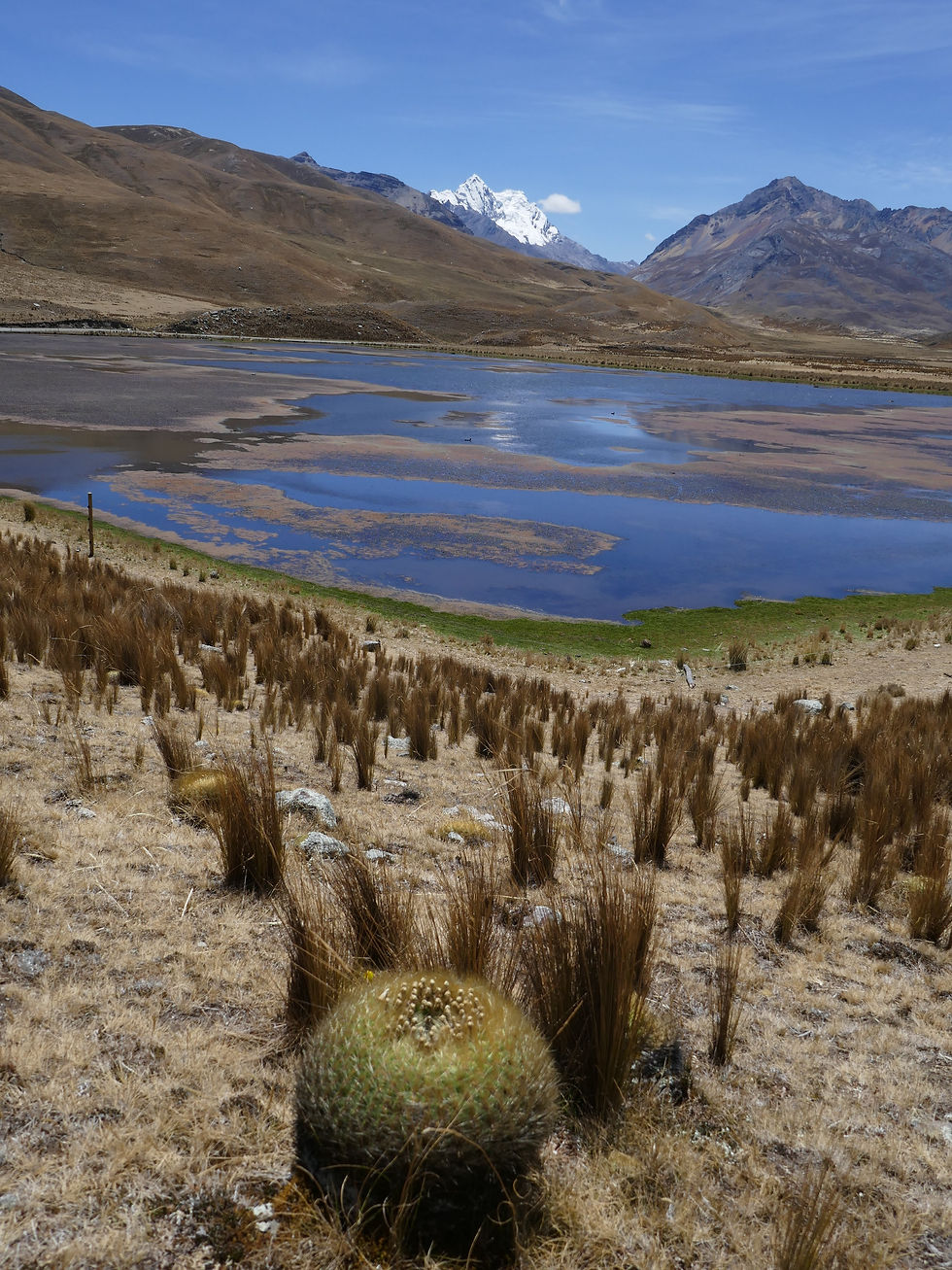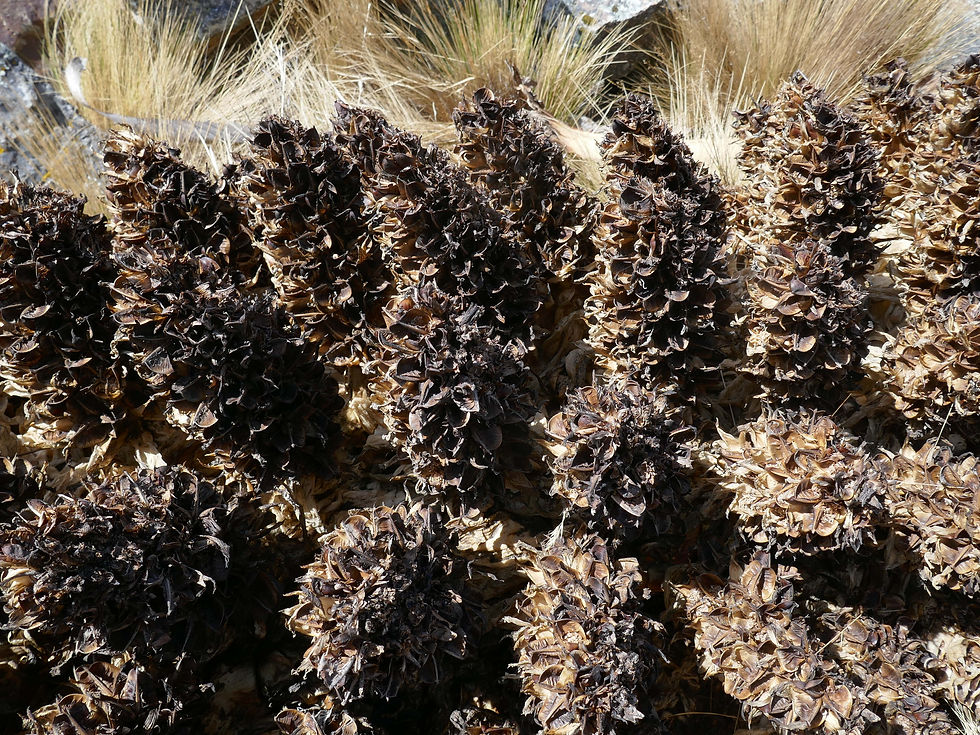MY LIFE WITH PLANTS: Peruvian Puya Pursuit.
- k-england
- Jan 1, 2020
- 3 min read
Updated: Jun 21, 2022

Puya Forest
By Jim Bishop.
This past September I joined a plant expedition tour to Peru. It was a different type of tour for me. The focus was mostly on seeing cacti and bromeliads growing in their natural habitats as opposed to visiting private and botanic gardens like most tours I’ve been on. I know I’m obsessive about plants, however, I’m a generalist who likes most plants, with many favorites including cacti and bromeliads. Much to my surprise I learned there are people more obsessed and very focused on very specific individual plants and plant families. In attendance were several Californians with strong interests in Bromeliads and Tillandsias, two people from the U.K. that were cactus enthusiasts, the largest succulent grower in Australia, and our guide who lives in Florida but is from Argentina. Still we saw a lot more plants than just cacti and bromeliads, we crossed the Andes 4 times (going over 14,000 feet several times), we visited Macchu Pichu, Isla de la Plata by boat (millions of birds), Leymebamba Mummy Museum, and other cultural and historic places. One of the main reasons I decided to go on the tour was the opportunity to visit Macchu Pichu, but also to see the largest member of the bromeliad family, Puya raimondii.

Jim Bishop and a blooming Puya raimondii.
The puyas we visited were in Huascarán National Park, a World Heritage Site, that spans world’s highest tropical mountain range and is part of the central Andes. To reach the puyas we traveled a long dirt road past treeless scenery, but with many other unique plants along the way. In fields we encountered a very fuzzy cactus with beautiful orange flowers (Austrocylindropuntia machacana) and it’s red flowered cousin, Austrocylindropuntia floccosa. We stopped at edge of highland lake with the snowcapped Andes in the background to look at a rare high-elevation barrel cactus, Oroya borchersii.

We also saw the red flower cactus, Matucana yanganucensis.

Matucana yanganucensis.
The lake also had a small population of a high elevation Coots and other endemic birds.
But the star of the day and of the plants we saw on the tour was Puya raimondii. also known as Queen of the Andes. It grows naturally in the high Andes in Bolivia and Peru at about 12,000 feet. Interestingly, it also grows well closer to sea level at the Berkeley Botanical Garden where 2 specimens bloomed in 2018. In the wild it normally doesn’t bloom until it has been growing for 80 to 100 years and like many in the bromeliad family of plants, it dies after blooming. Before blooming a single rosette can be as high as 16 feet and 8 feet across with as many as 200 narrow barbed leaves similar to Dasylirion wheeleri.

Immature Puyas.
The bloom Inflorescence can be up to almost 30 feet tall putting on quite a show. When in bloom it draws countless birds, mostly hummingbirds, to feed on the nectar and pollen of the flowers.

Puya in bloom.
Blooming usually occurs over a 3-month period and a single plant can have as many 20,000 individual flowers. After flowering, the plant slowly dies and dries out setting an untold amount of seed.

Puya seeds.
The dead plants can remain upright for several years with the inflorescence turning black above a brown skirt of dead leaves. Sadly, the plant is considered rare and endangered due to changes in climate and decreased habitat.
In 2018 there was a superbloom on P. raimondii with 100s of plants blooming simultaneously. The blooms were still standing, creating an impressive display even if the plants were now dead.

Puya forest.
Fortunately, we were able to find one plant in bloom this year and hike up to it. We were near 13,000 feet in elevation and it was located high above the road and required boulder hopping to reach it. We progressed very slowly and light-headedly at this elevation, stopping every few yards to catch our breath. Our efforts were rewarded with a spectacular view of the large tower of flowers with countless birds coming and going and chasing each other around the bloom. We balanced and leaned against many boulders staring in awe and took turns taking each other’s photos with the bloom. The bright tropical sun and thin air made it seem even more of a dream-like experience.

Alpacas and Andes.
Back on the dirt road on the way out of the park we encountered a couple of domesticated alpaca (Vicugna pacos) with a beautiful backdrop of the snowy Andean peaks. It was here that we picked up the same woman that we earlier bought treats from along the side of the road and she rode with us back into town.

Peruvian woman.




